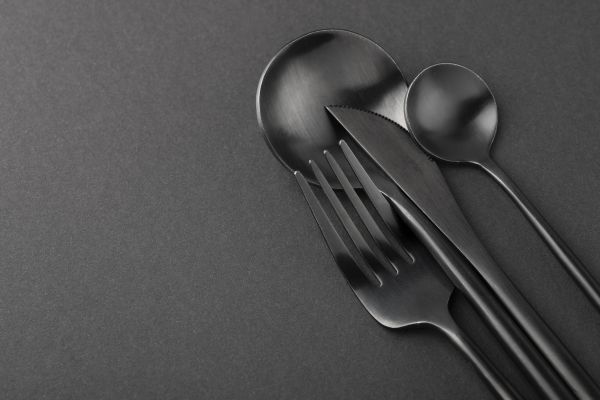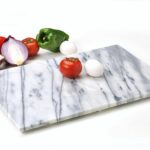Black silverware looks more sophisticated than traditional silverware. With its eye-catching black finish, black flatware adds a touch of elegance and uniqueness to the table setting. It helps create a luxurious dining atmosphere for special occasions but can also be a great way to breathe new life into everyday table settings.
Many users who want to have such flatware set on their dining table are interested in learning more about black cutlery. What is it made of? How strong and durable it is. Is the black color permanent? Does it contain harmful substances that could get into food? Today’s post will try to answer the most frequently asked questions about black silverware.
What Is Black Cutlery Made of?
Black cutlery is typically made of stainless steel and coated with an additional black layer. The quality of stainless steel and the quality of the coating may differ, which affects the quality of the cutlery.
PVD (physical vapor deposition) is a surface treatment that creates a thin film of metal (usually titanium) on stainless steel in a vacuum environment. PVD-coated flatware is highly resistant to scratches and discoloration and does not affect food taste.
Electroplated flatware may look similar, but it has a less durable finish that shows scratches quickly.
There is also black disposable cutlery made of plastic and painted black. We will talk more about plastic cutlery later.
Is Black Flatware Durable?
Black flatware is very durable if you choose a product made from high-quality materials. The most durable black flatware is made of high-quality stainless steel. 18/10 stainless steel is the most rust-resistant and has high overall durability. When it comes to the finish, PWD coating is the best option. PVD treatment improves wear and corrosion resistance. This type of coating also ensures that the black color lasts for many years without fading or discoloring.
Does Black Silverware Fade?
Many customers who have purchased black cutlery complain that their black cutlery set no longer looks the same after a few months. Black cutlery may fade or tarnish over time. This often happens when you wash your black cutlery in the dishwasher.
Maintenance is essential if you want to preserve the integrity of the black surface. The safest way of cleaning to ensure the longevity of the black color is to hand wash. Use mild cleaning products and avoid abrasive cleaners.
In addition, the black surface may fade if the cutlery comes into contact with acidic foods for a long time.
To minimize the risk of fading choose black silverware made from high-quality stainless steel that will not rust. The black finish should be applied by physical vapor deposition (PVD).
This type of coating is created by vaporizing the metal and then applying it to the surface of the silverware. This type of coating is durable and does not peel or fade over time.
How to Clean Black Silverware
Black flatware is more sensitive to washing than normal stainless-steel flatware. Even if the manufacturer claims your flatware set is dishwasher safe, the best method is to wash black flatware by hand. Hand washing helps maintain a smooth surface and reduces the risk of chipping and peeling. It also ensures the longevity of the black finish with no signs of fading or discoloration.
To avoid rust, remove leftover food immediately and rinse the cutlery as quickly as possible. Some foods like salt, vinegar, and mayonnaise are harsh to stainless steel and may cause pitting. To wash, use mild dish soap and a non-abrasive sponge and then rinse thoroughly. Don’t use abrasive powder cleaners or strong detergents (which contain phosphonates and polycarboxylates in the formula). Do not soak black silverware in soapy water for a long time.
If you still want to put your black flatware in the dishwasher, use a gentle cycle and avoid citrus-scented detergents. Also, avoid placing black flatware in the utensil basket to avoid scratching it.
Washing black silverware in the dishwasher can leave water stains on the surface. To remove these stains, hand dry them with a soft, clean cloth.
Is Black Silverware Toxic?
One of the main concerns with black flatware is the safety of the coating used to create the black color.
Black stainless-steel flatware with PVD treatment is completely non-toxic and hypoallergenic. According to the US Food and Drug Administration, PVD coatings are considered suitable for use in the food industry. With purchasing from reputable manufacturers, black flatware can be safely used with food.
The PVD process not only improves the food safety of cutlery but is also known to be safe, clean, and harmless to the environment.
Black Plastic Silverware
When it comes to safety, it is important to keep in mind the difference between black stainless-steel cutlery and black plastic cutlery.
Black plastic cutlery can look more attractive than regular plastic cutlery. In addition, like any other disposable cutlery, it saves you the hassle of washing dishes during and after larger gatherings such as weddings, birthday parties, picnics, and holiday parties.
Is Black Plastic Silverware Food Safe?
The use of black plastic cutlery has several serious disadvantages:
Items made of black plastic are not suitable for recycling due to their color, so they end up in other waste and increase the amount of environmentally harmful plastic waste.
Additionally, using any plastic with hot foods is not recommended as plastic can release harmful chemicals into the food at higher temperatures.
Finally, black cutlery can contain chemicals that can pose a health risk if used for long periods. The levels of some harmful chemicals in black cutlery are not regulated to protect consumers from possible harmful consequences.
For the reasons mentioned, it is not advisable to frequently use black plastic cutlery. A healthier alternative for users and the environment is disposable bamboo spoons, forks, and knives. If you choose plastic disposable cutlery, it shouldn’t be black plastic.




